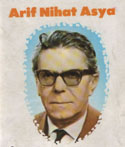ASYA, Arif Nihat
 Poet and writer (b. 7 February 1904, İnceağız Village, Çataka, İstanbul – d. 5 January 1975, Ankara). His father Ziver Efendi was from Tokat and his mother Fatma Hanım was from Tırnova (Bulgaria). His father died when Asya was a one-month baby and he grew under the protection of his relatives. He spent his childhood in poverty. He completed his secondary education as beneficiary student in Kastamonu and Bolu High Schools. Later he graduated from İstanbul Teacher Training School, Department of Literature (1927). He worked as a literature teacher and manager in various cities in Anatolia and Cyprus. He was Adana deputy between the years 1950-54. After working as teacher in Ankara Gazi High School, he retired (1962).
Poet and writer (b. 7 February 1904, İnceağız Village, Çataka, İstanbul – d. 5 January 1975, Ankara). His father Ziver Efendi was from Tokat and his mother Fatma Hanım was from Tırnova (Bulgaria). His father died when Asya was a one-month baby and he grew under the protection of his relatives. He spent his childhood in poverty. He completed his secondary education as beneficiary student in Kastamonu and Bolu High Schools. Later he graduated from İstanbul Teacher Training School, Department of Literature (1927). He worked as a literature teacher and manager in various cities in Anatolia and Cyprus. He was Adana deputy between the years 1950-54. After working as teacher in Ankara Gazi High School, he retired (1962).
He wrote his first article when he was a student in Kastamonu High School during the National Struggle period. His articles on politics and literature were published in the newspapers Yeni İstanbul and Babıali’de Sabah. Asya, known as the poet of flag, wrote his poem Bayrak (he Flag) in excitement on the day the city Adana became independent. He mostly gained fame through his poems especially through Bir Bayrak Rüzgar Bekliyor (A Flag is Waiting for Wind) and Fetih Marşı (The Conquest March). He drew the concrete and beautiful picture of his national sensitivity in his poetry. His style was very lively and full of enthusiasm. His subtle similes, cleverly made witty remarks, satires and puns are the complements of his style. Writing poems for his friends and putting dates in his poems have become his special pleasure. He wrote on history, geography, faith, art, Turkish people and being a Turk. He attributed a new role to rubai*, the verse of Divan* Poetry, and told about the traditional Turkish heroism in an emotional way. He introduced the nature, family, Turkish legends, towns, cities, and ramparts to rubai*. His poetry in terms of rubai* style included dialogues and half lines as well as titles. First Cemal Yeşil had used rubai*s in a different way, and then Asya widened the usage of it so there he started a ruba*i renaissance. Although it is poetry where he is most powerful in terms of literary works, he also had prose as beautiful and strong as his poems.
WORKS:
POETRY: Heykeltraş (The Sculptor, 1924), Yastığımın Rüyası (The Dream of My Pillow, 1930), Bir Bayrak Rüzgar Bekliyor (A Flag is Waiting for Wind, 1945), Kubbe-i Hadra (The Dome of Hadra, about Mevlana, 1956), Rubaiyyat-ı Arif (Rubai*s of Arif, 1956), Kovada Kalan (What’s Left in the Bucket, 1962), Kökler ve Dallar (Roots and Branches, 1964), Kıbrıs Rubaileri (Rubai*s of Cyprus, 1964), Nisan (April, 1964), Emzikler (The Nipples, 1964), Dualar ve Aminler (Prays and Amen, 1967), Kova Burcu (Aquarius, 1967), Aynalarda Kalan (What’s Left in the Mirrors, 1969), Avrupa’dan Rubailer (Rubai*s from Europe, 1969), Şiirler (Poems, 1971).
THOUGHT-ESSAY: Ayetler (Verses of Koran, 1936), Kanatlar ve Gagalar (Wings and Beaks, epigrams, 1964), Enikli Kapı (The Door with a Whelp, 1964), Terazi Kendini Tartamaz (The Scale cannot Weigh itself, 1967), Tevhit Mektupları (Letters Concerning Unification of Allah, 1967).